Chris & Allyson vs. Italy & Croatia (June-July 2019)
London: St. James Park, Buckingham Palace, Fortnum & Mason, Trafalgar Square, London Eye, Underbelly Festival, Westminster Abbey
London! Truly one of the world's great cities. A hub of culture, finance, pilfered cuisines and impeccable tailoring.
It is not, however, the first place one would think to visit on the Fourth of July. We have a respectful rapport with the British, and flaunting our victory in their capital is poor form. (And by flaunting, I mean simply walking around as a painfully obvious American, which is the only way some of us are capable of walking.) But the British had mucked up our travel plans, and so the consequences would be theirs to bear.
This was what they call a change of gears. We departed a country of 4 million, to tackle a city of 8 million. Zagreb's airport was bordering on quaint, while Heathrow may be larger than many Croatian cities. We opted to stay in the belly of the beast, so after a 45 minute Uber ride, we were safely ensconced at the Marlin Waterloo. It was a mere stone's throw from the Thames, although throwing a stone would be inadvisable. If you accidentally hit an MP, that's a whole other change to your travel itinerary. It was close to 3 p.m., so we grabbed a snack at a nearby, quintessentially British eatery next to the hotel — if memory serves, it was called Pret a Manger. With our superior command of the local language and patriotic fervor in hearts, we stepped out to see what all the rebelling was about.
I have an innate sense of direction, and if armed with a street map and enough time for two false starts, I can get you where you want to go in most cities. Allyson has no sense of direction, and so she has ceded full control of our ramblings to me. I opted for a swing around the circle, to parade the American dream past as many of our cruel oppressors as possible.
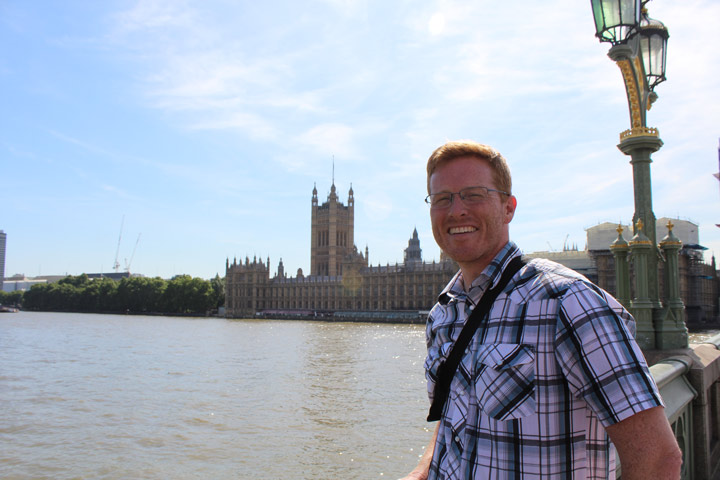
A not so foggy day in London town.

Sometimes, you gotta go full tourist.
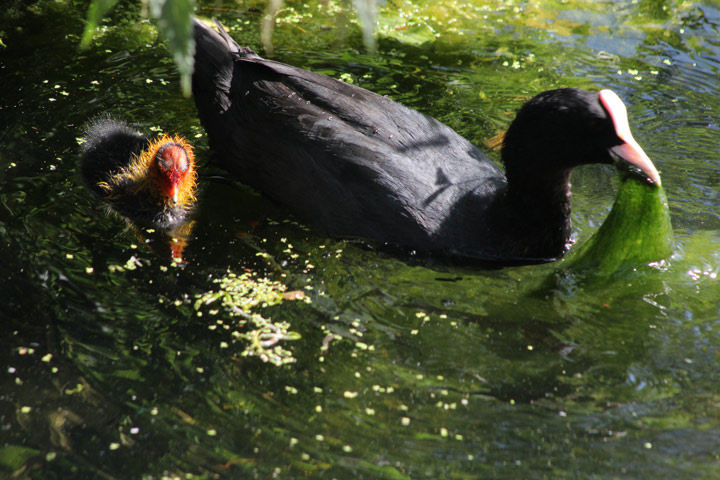
Making friends at St. James Park.
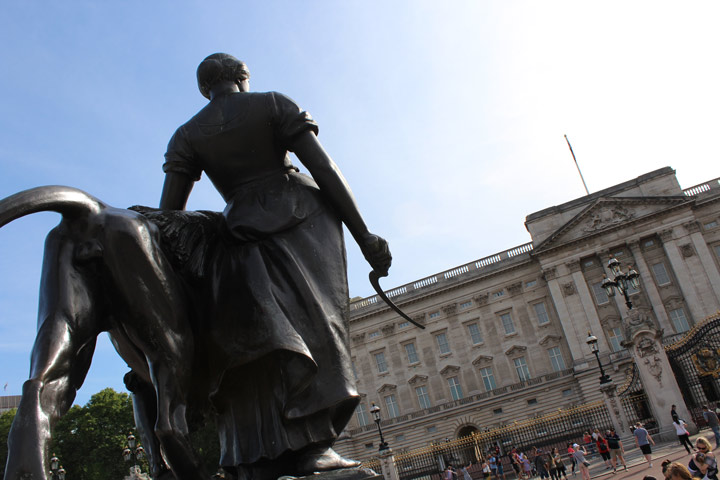
Taking a peek at Buckingham Palace.
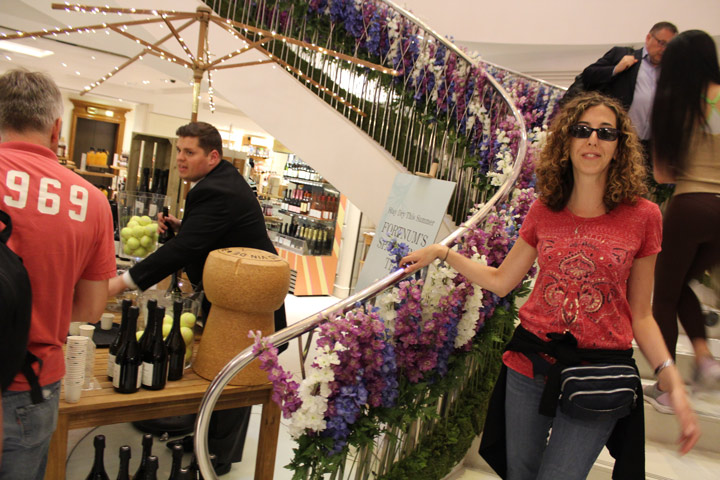
A pit stop in Fortnum & Mason, one of London's department stores.
Crossing Westminster Bridge brought us directly to the site of so many grave injustices against the colonies: Parliament. Big Ben was under scaffolding, and we had no illusions of touring the place, but we were sorely disappointed that the traffic circle from "European Vacation" had apparently been removed. 10 Downing Street was also somewhat fenced off, but we projected colonial vibes in its general direction. A passageway at Dover House took us to the Horse Guards Parade Grounds — hard to believe that we liberated ourselves from a nation with a proud tradition of horse guards — and from there we proceeded to St. James Park.
It's a lovely park, offering sanctuary to countless birds in the middle of a notoriously dreary metropolis. The natural beauty is in no way diminished by the fact that royalty in nearby Buckingham Palace almost certainly used the park to hunt people for sport, allegedly. Informative signage, one of the lasting legacies of the British Empire, indicated that pelicans had lived in the park for more than 400 years. We have pelicans in the states, so this seems like an odd flex, but it means something to the Brits. We admired the cottage on Duck Island, which dates to the Martin Van Buren administration, and we were quite pleased to see that the waters were festooned with baby ducks. They were awkward and weird in the best British idiom, but they were baby ducks nonetheless.
All this was a mere prelude for us to shake our fists angrily at Buckingham Palace. When our arms tired, we retreated to the statues of the Victoria Memorial and meandered with the crowds. It was at this point that Allyson asked one of the probing questions one would expect from a woman who had recently gained the wisdom of another year: What exactly is the deal with the British government? I'm supposed to be knowledgeable about these things, so I certainly mustered a very convincing response, not far from what you might have heard at Faneuil Hall in the 1770s.
The discussion continued as we made our way through Green Park and stopped briefly at the Canada Memorial. We gave up on trying to understand the U.K. as we reached Piccadilly, for now we were fully absorbed in our new enterprise: ticking off London cliches. Harrods was a bridge too far, but the classy thing about London is that you can't spit without hitting a 300-year-old business. We hopped into Fortnum & Mason, a department store older than our country, and honored their place in history by using their bathrooms. We also window shopped in their food and wine departments for good measure, before meandering through Piccadilly Circus en route to Trafalgar Square.
Our hometown of Washington is jammed with profound public spaces, but Trafalgar Square has at least six centuries on any meaningful patch of American dirt. It is named for the battle of Trafalgar, where Admiral Nelson lost his life in defense of the empire. He and other admirals now stand in metal form on columns around the square. The "fourth plinth" was earmarked for a statue of William IV, but the funds never materialized; maybe William should have done the sensible thing and gotten shot in battle. The empty plinth served as a monument to inadequate budgeting until the end of the 20th century, when smart intellectual types decided to repurpose it for modern art and whatnot. This is a delightful program, which we had already enjoyed: one of the temporary sculptures, an enormous electric blue rooster, is now on display about a mile from our house at the National Gallery of Art. In 2019, we were treated to "The Invisible Enemy Should Not Exist." I defer now to the world's leading expert on art and British culture, Wikipedia:
"A recreation of a sculpture of a lamassu (a winged bull and protective deity) that stood at the entrance to Nergal Gate of Nineveh from 700 B.C. It was destroyed in 2015 by Isis, along with other artefacts in the Mosul Museum. Rakowitz's recreation is made of empty Iraqi date syrup cans, representing the destruction of the country's date industry."
After much careful deliberation, it was deemed cool, although not cool enough to keep us from our appointment. Saying goodbye to depressing Iraqi history, we crossed the Golden Jubilee bridge on foot to reach the London Eye.
London has roughly 2,000 years of history, so naturally its most popular attraction is an American invention wheel put in place for the millennium. Among our intrepid party, only I had ridden the beast before, and the story is mildly worth telling: In the dark times before I was married, I was heavily involved with another woman. In the fourth year of our relationship, she felt it was important to take a year and study abroad in London. This should have been an immediate red flag, but you can't have character development without colossal errors in judgment, so there's no use pouting about it. In the second half of that year, I scrimped together the resources to visit her — this was a Very Big Deal, because I was working as a full-time stand-up comedian at the time, and by "working" I mean "making no money." It was an odd visit, where whe was distressingly distant for most of the trip. And maybe the most confusing moment was when she refused to go on the London Eye with me, suddenly claiming a fear of heights that seemed suspiciously new. When she returned to the U.S., she revealed that she had been sleeping with a guy in London, though she was vague as to the timeline. We broke up shortly thereafter, ultimately clearing the field for a much happier life. But I now believe that she was terrified that I would propose on the London Eye. You can't erase memories, but you can try to overwrite them. This time, instead of riding by myself, I'd take two women.
While British Airways cruelly forced us into an extended vacation, Fate did its part to soften the blow. Our good friend Anita was on vacation in London, and our layover lined up with her trip. She was enjoying an extremely British day — she spent the morning watching tennis at Wimbledon — but had a window to meet us in central London around 7 p.m. The miracle of advance reservations did the rest. We had extra-special (i.e. more expensive) "fast pass" tickets, meaning we could board the Eye any time we wanted. Once our friend found us, we queued up and were whisked off to the adventure of a lifetime!
Which is to say, in your lifetime, you will rarely experience a very slow, smooth, 30-minute circular journey. And when you do, it's an even bet whether that journey is taken alongside several strangers in your Ferris wheel pod, including one little girl who insists on playing with a robot dog the entire time. The journey does afford excellent views of London, however, and Fate again cooperated by holding off the clouds and haze and typhoid fog that blanket the city 90 percent of the time. We took delightful photos, gave an appropriate amount of side-eye to the robot dog, and returned to Earth better people.

Trafalgar Square!
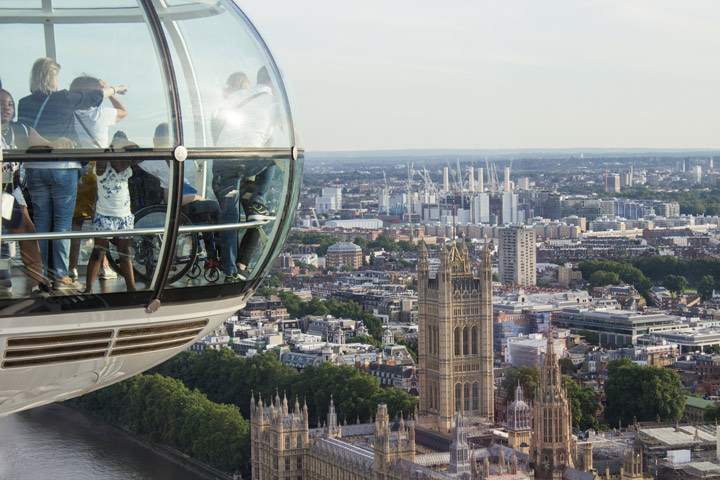
The London Eye did not disappoint.

A view that most English royalty never enjoyed.
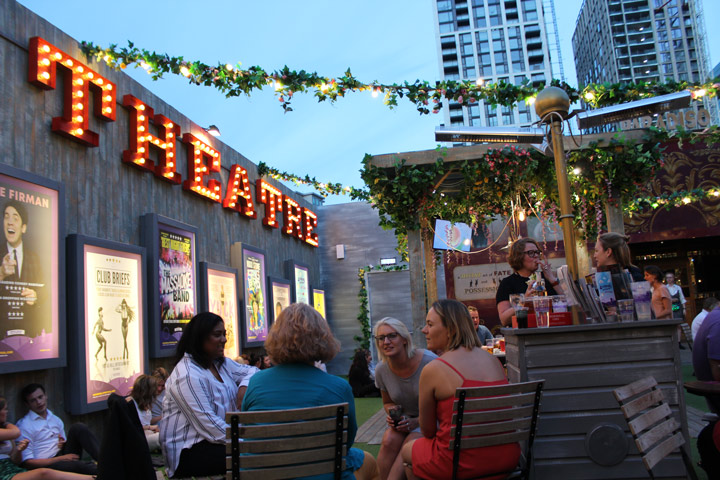
Unwinding at the Underbelly Festival grounds.
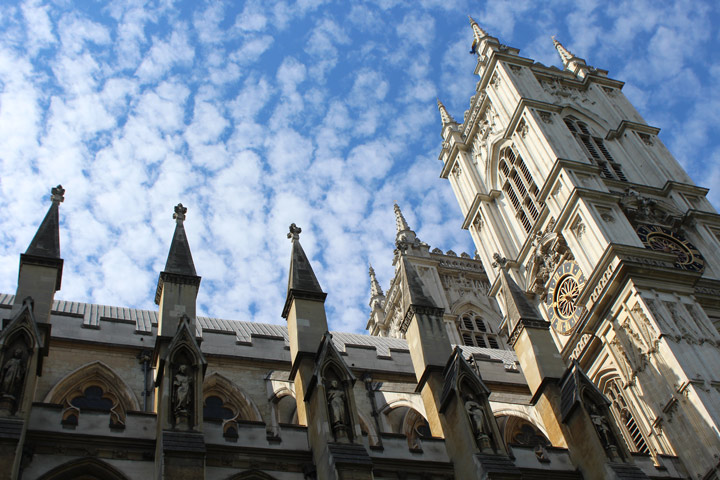
Westminster Abbey!
The evening was closed at the Underbelly Festival, a fringe-type event featuring comedy, drag shows, variety shows and an outdoor beer garden. Perhaps its greatest feature, however — and certainly the selling point to us — was that the festival entrance was roughly 300 feet from the London Eye. The only thing British people should eat on July 4 is crow, but as proud Americans we felt no shame in feasting on burgers, croquettes and falafel. We established ourselves at a table and enjoyed the crowd, swapping vacation stories until the sun went down. It was a glorious day, made possible by the United States of America and its world-beating citizens.
Our time in London wasn't quite over, since we didn't have to return to Heathrow until 2 p.m. on July 5. There was still time to do something British, particularly since we opted to stay in the heart of London. Friday morning, we stashed our bags at hotel, checked out, and crossed the river once again for Westminster Abbey. They do not allow pictures inside, so these words will have to suffice.
England's most famous church is 20 pounds of history in a 10-pound bag; most surfaces are either covered with art or covering a dead body. Any tour that stars with you trodding over the remains of Charles Darwin, Stephen Hawking and Isaac Newton is going to be a banger. I particularly enjoyed the alcoves holding Elizabeth and Mary Queen of Scots; when you read so much history it's nice to see how some of the stories ended. Before long you're up close with the famous floor where coronations take place; and you wrap up standing among literary giants at "Poet's Corner." We paid a bit extra to explore the Queen's Jubilee Galleries, showcasing funeral effigies from the royals (some in wax, some in wood), a few more exhibits on the building of the Abbey, replicas of the coronation jewels, and the spare coronation chair from the time a queen and king were co-regents. Almost as an afterthought, they had an original copy of the Magna Carta. They even had the marriage license of William and Kate, framed and hung on the wall.
For most of the long history of Westminster Abbey, seeing the Abbey would be the end of your day. You'd retire somewhere, maybe pour yourself something to drink, and contemplate one of the most significant civic and spiritual spaces in the tapestry of Western Civilization. You'd ponder the army of world-beaters that passed through its doors. The world at large belonged to the heroes enshrined within; it was their onus to cross the oceans and plant the seeds of Anglo-Saxon civilization — a task that was unimaginable to most mortals.
We, on the other hand, would be on another continent within a few hours. We stopped at a Tesco Express to grab some bottled water and tampons, had a talkative Ugandan Uber driver take us to the airport, then nonchalantly made a journey that once would have defined a man's existence.
For all its glory, the world is now a small place. The real adventure comes from experiencing it with the people you love. This was a great adventure. With Allyson, they always are.
